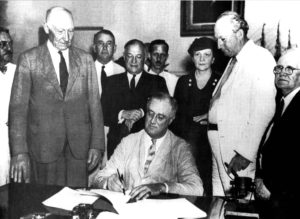Progressive Party Standpoint
Whenever a new political party arises, there is always a rush as the new party establishes and publicizes its standpoint on a variety of matters. During the 1912 election, there were six contestants running for the presidential office due to dissatisfaction with the republican and democrat parties. As the official ballot that has been preserved by Kenosha News shows, former president Theodore Roosevelt was running again in 1912 under the progressive party (1). Understanding this political environment is crucial for understanding documents written during that time period. For instance, Joseph P. Chamberlain’s letter to Jane Addams of Hull House about the progressive party’s stand on old age and sickness insurance is easier to understand with this political backdrop in mind (2). In the letter, Joseph P. Chamberlain, a member of the progressive party and a respected professor at Columbia University, urges Miss Addams, an American settlement activist, to, “call a meeting of your committee, together with the heads of departments of the Progressive Service and, if possible, the National Committees, to take up, broadly, the stand of the Party in regard to certain questions of policy and practicability”(2). In other words, Joseph P. Chamberlain wanted Miss Addams’ assistance in calling together a meeting of distinguished leaders to discuss the various aspects of old age and sickness insurance, like implementation and finances. The goal of this meeting was to help the progressive party take a position on these topics which they have been unable to do so far due to insufficient consideration and the tentative results that the Special Committee on Sickness and Old Age Insurance had produced. A few years after this letter was written, the Social Security Act, SSA, of 1935 was signed into law by President Franklin D. Roosevelt and The Opp Weekly New of Alabama wrote whole articles dedicated to explaining the various aspects of the Social Security Act to the masses (3). The articles explain how “old-age insurance benefits are based on the total wages received in covered employment between January 1, 1937, and age 65” (3). To clarify, the Social Security Act is a federal program where the government collects a portion of each individual’s wages in exchange for payments to these same individuals after retirement based on their income during employment.

But how does the Social Security Act connect to, single-payer health insurance (My topic of choice)? The Social Security Act is a perfect example of mandatory insurance controlled by a department of the federal government that benefits citizens in their time of need. Furthermore, all that a citizen needs to be eligible is their social security card. On the other hand, the current health system has individuals choose between packages, hunt for doctors that are covered, then constantly worry about wither their medication or operation is covered. In essence, the Social Security Act is somewhat similar to the single-payer health plan where the individual will not need to worry about a complex system but will simply need to pay their taxes, which most people already do on a normal basis, and have their social security number on hand when they fall ill. However, as the Boston Globe states, that while “it does seem like the most efficient health care systems have a lot of government involvement….you still need a plan to get there” (4). There is still a lot of planning left on the part of the government as they must find a way to gather the funds required to run a federal healthcare system without raising taxes too much.

Footnotes:
- “28 Oct 1912, 2 – Kenosha News at Newspapers.com.” Newspapers.com, www.newspapers.com/image/595367940/?terms=president+Roosevelt+progressive+party.
- “Joseph P. Chamberlain to Jane Addams, January 10, 1914.” Jane Addams Digital Edition, https://digital.janeaddams.ramapo.edu/items/show/6929.
- “18 Aug 1938, 4 – The Opp Weekly News at Newspapers.com.” Newspapers.com, www.newspapers.com/image/553477924/?terms=old+age+insurance.
- “14 Sep 2017, A10 – The Boston Globe at Newspapers.com.” Newspapers.com, www.newspapers.com/image/444658684/?terms=single+payer.








/arc-anglerfish-arc2-prod-tronc.s3.amazonaws.com/public/RZIRKRUAHVF2XMBRGNMD6HVOKM.jpg)